
Studi e Saggi Linguistici
Scope & Guideline
Fostering Critical Dialogues in Language Studies
Introduction
Aims and Scopes
- Historical Linguistics and Language Change:
The journal frequently publishes studies examining the evolution of languages, focusing on morphological, phonological, and syntactic changes over time, particularly in Indo-European and Romance languages. - Morphosyntactic Analysis:
A core area of research involves detailed analyses of morphosyntactic structures, including the study of grammatical categories, syntactic constructions, and their semantic implications across different languages. - Phonology and Phonetics:
Research on phonological systems, sound changes, and the phonetic realization of linguistic elements is prominent, with studies often exploring the phonetic and phonological characteristics of various languages. - Language Typology and Description:
The journal emphasizes linguistic typology, offering comparative studies that classify languages based on structural features and describing lesser-studied languages and dialects. - Sociolinguistic Perspectives:
There is a growing interest in the sociolinguistic aspects of language, including language variation, contact, and the social implications of linguistic phenomena. - Interdisciplinary Approaches:
The journal encourages interdisciplinary research, integrating perspectives from fields such as cognitive science, anthropology, and pathology to enrich linguistic studies.
Trending and Emerging
- Indefinite Quantifiers and Numerals:
Recent studies have increasingly focused on the interaction between indefinite quantifiers and numerals in various languages, exploring their syntactic and semantic properties, which indicates a growing interest in quantification in linguistics. - Explorations of Language Variation:
There is a noticeable trend towards investigating regional varieties and dialects, particularly within Romance languages, highlighting the journal's commitment to documenting and analyzing linguistic diversity. - Morphological Studies of Slang and Informal Language:
Research on the morphosyntactic features of slang and informal registers has surged, reflecting a broader interest in the dynamics of language use in contemporary settings. - Cross-Linguistic Comparisons:
An increase in studies comparing linguistic features across different languages signals a trend towards a more global perspective in linguistic research, emphasizing typological and comparative analyses. - Phonetic Reduction and Speech Patterns:
Emerging studies on phonetic reduction strategies in spoken language suggest a growing interest in the relationship between phonetics and everyday language use, particularly in informal contexts.
Declining or Waning
- Language and Pathology:
Research connecting linguistic structures with developmental language disorders and other pathologies appears to be less frequently addressed in recent issues, possibly indicating a shift towards more traditional linguistic studies. - Translation Studies:
While translation strategies were once a more prominent theme, recent publications suggest a decline in this area, with fewer studies exploring the intricacies of translation in historical texts. - Narrative and Discourse Analysis:
The focus on narrative abilities and discourse analysis has diminished, suggesting a potential waning interest in these topics within the journal's scope. - Linguistic Criticism and Historical Texts:
Although still present, the frequency of papers critically analyzing historical linguistic texts has decreased, indicating a possible shift towards more empirical and data-driven linguistic research. - Philosophical Linguistics:
Discussions surrounding the philosophy of language, including the conceptual foundations of linguistic theories, seem to be less prevalent, reflecting a possible trend toward more empirical methodologies.
Similar Journals

Language and Linguistics Compass
Charting New Territories in Language and LinguisticsLanguage and Linguistics Compass, published by Wiley, stands as a premier journal in the field of linguistics, showcasing innovative and interdisciplinary research. With its ISSN 1749-818X and E-ISSN matching, the journal has built a robust reputation, achieving an impressive Q1 ranking within the linguistics category for 2023, placing it in the top 4% of its field. Its Scopus rank of 48 out of 1167 highlights its influence and significance among linguistics journals, boasting a commendable 95th percentile. This journal serves as a vital resource for researchers, professionals, and students, offering a wide range of accessible articles that illuminate current trends and advances within the domain of language studies. Although it is not Open Access, the journal is committed to quality and diversity in its publications, ensuring scholarly articles from various sub-disciplines of linguistics are represented from 2008 through 2024. Located in the United Kingdom, Language and Linguistics Compass invites contributions from around the globe, reinforcing its status as a leading forum for linguistic discourse.
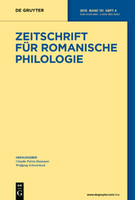
ZEITSCHRIFT FUR ROMANISCHE PHILOLOGIE
Exploring the Rich Tapestry of Romance Languages and LiteratureZEITSCHRIFT FUR ROMANISCHE PHILOLOGIE, published by Walter de Gruyter GmbH, stands as a prominent peer-reviewed journal dedicated to the fields of Linguistics, Literature, and Literary Theory. Established in 1877 and continuing its legacy to the present day, this esteemed journal offers a platform for comprehensive scholarship that explores the intricacies of Romance languages and their literary heritage. With a notable Q1 ranking in Literature and Literary Theory and a Q2 ranking in Linguistics and Language, it has secured its place among leading resources in the humanities. Researchers, educators, and students benefit from its rich historical context and current contributions to the understanding of Romance languages and literature. Though currently not available as Open Access, the journal prioritizes the dissemination of high-quality research, making significant strides in fostering academic dialogue and advancement. Its address at Genthiner Straße 13, Berlin, Germany, situates it in a hub of scholarly activity, bridging the past with contemporary literary discourse.
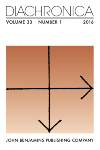
Diachronica
Charting the Course of Linguistic TransformationDiachronica is a prestigious academic journal published by John Benjamins Publishing Co that specializes in the fields of Linguistics and Philosophy. Established in 1984, it has become a significant platform for researchers and scholars to disseminate their work on language change and diachronic linguistics, offering insights into the evolution of languages over time. With an impressive impact factor and recognized rankings within the Q2 category for both Linguistics and Language as well as Philosophy in 2023, Diachronica offers a valuable resource for academics interested in the interplay between historical linguistics and philosophical discourse. Although the journal is not open access, it ensures that its articles are rigorously peer-reviewed and of high academic quality. For researchers, professionals, and students looking to deepen their understanding of language dynamics, Diachronica stands out as an essential component of the scholarly dialogue surrounding linguistic change.
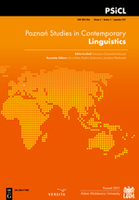
Poznan Studies in Contemporary Linguistics
Elevating linguistic insights for a global audience.Poznan Studies in Contemporary Linguistics, published by DE GRUYTER MOUTON, is a pivotal journal in the field of linguistics, with an ISSN of 0137-2459 and an E-ISSN of 1897-7499. Located in Germany, this esteemed journal has consistently contributed to the academic landscape since its inception. As of 2023, it holds a Q2 category rank in Linguistics and Language and boasts commendable Scopus rankings, featuring in the 69th percentile for Arts and Humanities and the 66th percentile for Social Sciences. The journal emerges as a vital platform for scholars to explore contemporary linguistic theories and practices, making it an essential resource for researchers, professionals, and students alike. With a converged publication period from 2007 to 2024, it aims to facilitate a deeper understanding of linguistic advancements and trends. While the journal currently does not offer open access, its rigorous peer-review process ensures the highest quality of published research, strengthening its role as a leading discourse in the dynamic field of linguistics.
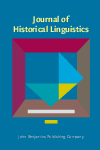
Journal of Historical Linguistics
Unlocking the Secrets of Language HeritageJournal of Historical Linguistics, published by JOHN BENJAMINS PUBLISHING CO, is an esteemed peer-reviewed journal that has carved a niche in the intricate field of linguistics and language. With its ISSN 2210-2116 and E-ISSN 2210-2124, the journal has made significant contributions since its inception in 2011, continuing its impactful discourse until 2024. Located in the Netherlands, the journal showcases a commitment to advancing our understanding of language evolution, change, and historical linguistics, providing invaluable insights for researchers, professionals, and students alike. As demonstrated by its commendable rankings—placing it in the Q3 quartile for linguistics and language with a Scopus rank of #275 out of 1088—this journal stands as a critical resource for those invested in the empirical and theoretical aspects of language history. Its accessibility enhances its reach, allowing for a wider distribution of knowledge in this vital scholarly area.

STUF-Language Typology and Universals
Unveiling the Secrets of Language DiversitySTUF-Language Typology and Universals, published by WALTER DE GRUYTER GMBH, is a renowned journal in the field of linguistics focusing on language typology and universals. With an ISSN of 1867-8319 and an E-ISSN of 2196-7148, this journal has established itself as a significant source of scholarly research, evidenced by its strong rankings, including a Q2 classification in the linguistics category for 2023. The journal aims to explore the rich diversity of languages while seeking to uncover the underlying principles that govern their structures and functions. Its interdisciplinary scope appeals to linguists, cognitive scientists, and social scientists alike, fostering a deeper understanding of language as a fundamental human capacity. Researchers and professionals are encouraged to contribute to this academic discourse, as it plays a vital role in advancing the field of language studies. With access options through various platforms, STUF continues to disseminate high-quality research and stimulate innovative thoughts within the linguistic community, making it an indispensable resource for scholars and students worldwide.
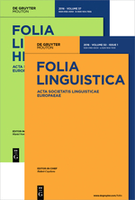
FOLIA LINGUISTICA
Pioneering Research at the Forefront of LinguisticsFOLIA LINGUISTICA, published by WALTER DE GRUYTER GMBH, is a premier scholarly journal dedicated to the field of linguistics. Established in 1967, the journal has consistently provided a platform for innovative research and scholarly discourse in language and linguistics, contributing significantly to the academic community's understanding of language structures, usage, and cognitive processes. With its classification in the top quartile (Q1) of linguistics and language in 2023, FOLIA LINGUISTICA holds a respectable rank (#282/1088) within the Arts and Humanities category and an admirable percentile rank of 74th, ensuring its position at the forefront of linguistic scholarship. Researchers and academics from around the globe can access a wealth of knowledge and cutting-edge research findings through this esteemed publication, which is vital for anyone looking to engage with the latest advancements in linguistics. Located in Berlin, Germany, FOLIA LINGUISTICA encompasses all aspects of language research, making it an indispensable resource for researchers, professionals, and students alike seeking to deepen their understanding of language and its complexities.

Catalan Journal of Linguistics
Exploring the Richness of Catalan Linguistics.Catalan Journal of Linguistics is a distinguished academic publication dedicated to the dynamic field of linguistics and language studies. Published by the Universitat Autònoma de Barcelona, this open-access journal has been disseminating impactful research since 2002, making significant contributions to the understanding of linguistic theory, language acquisition, and sociolinguistics, particularly within the Catalan language context. With a robust engagement in the scholarly community, it proudly holds a Q2 ranking in Linguistics and Language as of 2023, reflecting its commitment to high standards of research and innovation. The journal is accessible to a global audience, promoting the free exchange of knowledge beyond geographical boundaries, and serves as an essential platform for researchers, professionals, and students aiming to stay at the forefront of linguistic inquiry. With its rich archive of articles, the Catalan Journal of Linguistics stands as a vital resource for anyone keen to explore contemporary linguistic issues and advancements.
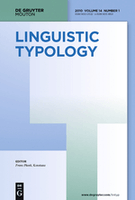
Linguistic Typology
Charting New Territories in Language TypologyLinguistic Typology is a premier journal focused on the comparative study of language structures and the classification of languages, published by Walter de Gruyter GmbH in Germany. Since its inception in 1997, the journal has established itself as a leading platform in the field of linguistics, achieving a remarkable Q1 category ranking in both Linguistics and Language for 2023, reflecting its impact and relevance among scholars. With a notable position in the academic community, evidenced by its 91st percentile rank in Arts and Humanities and 90th percentile in Social Sciences according to Scopus, Linguistic Typology invites contributions that explore the rich diversity of language structures, promoting a deeper understanding of linguistic phenomena across various cultures. While currently not offering open access, the journal remains a pivotal resource for researchers, professionals, and students aiming to advance their knowledge in the dynamic field of linguistics. For more information, deliverables, and submission guidelines, please visit the journal's official page.

Sign Language & Linguistics
Connecting Scholars in the World of Sign LinguisticsSign Language & Linguistics is an esteemed academic journal published by John Benjamins Publishing Co, dedicated to advancing the field of sign language studies and linguistics. With an ISSN of 1387-9316 and an E-ISSN of 1569-996X, this journal has earned a prominent place in the linguistic community, achieving a Q1 ranking in both the Linguistics and Language category, and standing out within the Scopus rankings, placing in the 77th percentile among the Arts and Humanities and 75th percentile in the Social Sciences categories. Sign Language & Linguistics spans over two decades of research, offering comprehensive insights and analyses from 1998 to 2024, promoting high-quality scholarly communication. Aimed at researchers, professionals, and students alike, this journal is essential for those exploring the intersection of sign languages, linguistics, and cultural studies, facilitating progressive discourse and fostering an understanding of this vital mode of human communication.